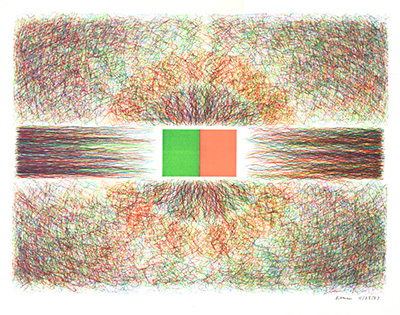
Cosmic Immersion, Algorithmic pen & Ink Drawing, (24" by 18"),
Plotted drawing on paper, 28 November,1987. Artist's software,
HODOS with a Houston Instruments DMP52 plotter.
main menu | history | site map | search | contact | copyright | home
<< return to Venice Exhibition, 2017

Cosmic Immersion,
Algorithmic pen & Ink Drawing, (24" by 18"),
Plotted drawing on paper, 28 November,1987. Artist's software,
HODOS with a Houston Instruments DMP52 plotter.
The Software, HODOS. During this period I developed routines in my master program, HODOS, that allowed me to play with the "resolution of opposites" as I did in my New City paintings in the 1960's. My software, HODOS, employed a randomizer operating within parameters of "not more than" and "not less than specified limits to determine coordinates (x,y) for every radiant pen stroke in this work except for the geometric squares. The entire structure is a dance between "order" and "chance"*. The Houston Instruments DMP52 plotter had 14 pen stalls. I mixed inks for the palette of ink pens and my software employed chance for choosing ink pens (color choice) with the exception of the red & green for the central rectangles.
Note on computer randomizers. Computers employ pseudo-randomizers that approximate random behavior. A pseudo-random procedure, known as a Deterministic Random Bit Generator (DRBG), is initiated with an arbitrary number called a "seed". A new "seed" sets the routine to generate a new sequence of pseudo-random numbers. A coded art-form generator, given a new seed, generates a new form in a family of forms. This procedure is outlined in my 1968 paper "Epigenetic Art: Software as Genotype".
Structure and Interpretation. One could also look at this work as the cosmic dance between order and chaos. The dialectic between rational structure and chance behavior is present in the pen strokes here in a way similar to that as noted previously for "Cosmic Immersion".
In this series, as with his Gaia Series, the art work praises the Sun and the Earth. My interest in the ecology of the Earth dates from Rachel Carson's Silent Spring (1962). Since leaving monastic life I came to view and celebrate our nature preserves as the Sanctuaries of our time. My teaching and my art work have been deeply committed to what I view as an "ecological ethic" that recognizes our responsibility to "other life" and the health of our Mother Earth.
During my monastic period, I created an art panel based on Saint Francis of Assisi’s “Canticle of the Sun,” known also as “Praises” or Laudes. Those praises celebrate the Earth, the Sun and all forms of life on the Earth. For the Algorithmic Signs exhibition in Venice (Italy) I appended an Umbrian version of the Saint Francis Canticle:
SUN CANTICLE
Original
text in Umbrian dialect:
[1]
Altissimu,
onnipotente bon Signore,
Tue so le laude, la gloria e l'honore et onne benedictione.
Ad Te solo,
Altissimo, se konfano,
et nullu homo ène dignu te mentouare.
Laudato sie, mi
Signore cum tucte le Tue creature,
spetialmente messor lo frate Sole,
lo qual è iorno, et allumini noi per lui.
Et ellu è bellu e radiante cum grande splendore:
de Te, Altissimo, porta significatione.
Laudato si, mi
Signore, per sora Luna e le stelle:
in celu l'ài formate clarite et pretiose et belle.
Laudato si, mi
Signore, per frate Uento
et per aere et nubilo et sereno et onne tempo,
per lo quale, a le Tue creature dài sustentamento.
Laudato si, mi
Signore, per sor'Acqua,
la quale è multo utile et humile et pretiosa et casta.
Laudato si, mi
Signore, per frate Focu,
per lo quale ennallumini la nocte:
ed ello è bello et iucundo et robustoso et forte.
Laudato si, mi
Signore, per sora nostra matre Terra,
la quale ne sustenta et gouerna,
et produce diuersi fructi con coloriti fior et herba.
Laudato si, mi
Signore, per quelli ke perdonano per lo Tuo amore
et sostengono infirmitate et tribulatione.
Beati quelli ke 'l
sosterranno in pace,
ka da Te, Altissimo, sirano incoronati.
Laudato si mi
Signore, per sora nostra Morte corporale,
da la quale nullu homo uiuente pò skappare:
guai a quelli ke morrano ne le peccata mortali;
beati quelli ke trouarà ne le Tue sanctissime uoluntati,
ka la morte secunda no 'l farrà male.
Laudate et benedicete
mi Signore et rengratiate
e seruiteli cum grande humilitate.
Notes: so=sono, si=sii (you are), mi=mio, ka=perché, u replaces v, sirano=saranno